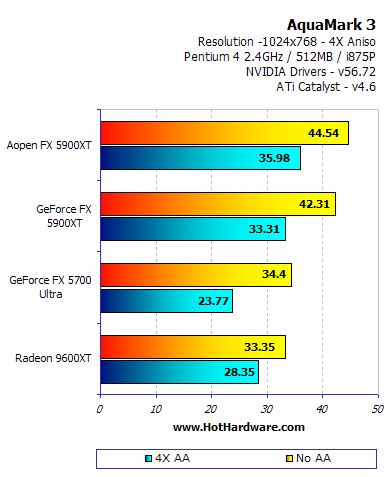AOpen GeForce FX 5900XT Review
|
| AquaMark 3 comes to us by way of Massive Development. Massive's release of the original Aquanox in 1999 wasn't very well received by the gaming community, but it was one of the first games to implement DX8 class shaders, which led to the creation of AquaMark 2 - a benchmark previously used by many analysts. Since the AquaMark benchmarks are based on an actual game engine, they must support old and new video cards alike. Thus, the latest version of AquaMark, AquaMark 3, utilizes not only DirectX 9 class shaders, but DirectX 8 and DirectX 7 as well. We ran this benchmark at resolutions of 1024x768 and 1600x1200 with no anti-aliasing and then with 4x AA enabled. |


In the AquaMark 3 tests, the AOpen GeForce FX 5900XT topped the stock 5900XT by an average of 2-3FPS. The additional 30MHz the AOpen GeForce FX 5900XT sports gives it an extra boost of 7.5%, but in the end, this changes the big picture very little.
|
| For many gamers, the release of Halo marked the end of a long wait, since it was originally released as an Xbox exclusive a few years back. No additional patches or tweaks are needed to benchmark with Halo, as Gearbox has included all of the necessary information in their README file. The Halo benchmark runs through four of the cut-scenes from the game, after which the average frame rate is recorded. We patched the game using the v1.02 patch and ran this benchmark twice, once at 1024x768 and then again at 1280x1024. Anti-aliasing doesn't work properly with Halo at the moment, so all of the test below were run with anti-aliasing disabled. |


With Halo, there was little gained by running the 5900XT at 420MHz, with both 5900XT models running a tight race. When we increased the resolution to 1280x1024, this allowed each card's performance to come into play as the CPU became less of a bottleneck. Here, the AOpen card's increased core clock speed became more advantageous, adding 4FPS to the results.








